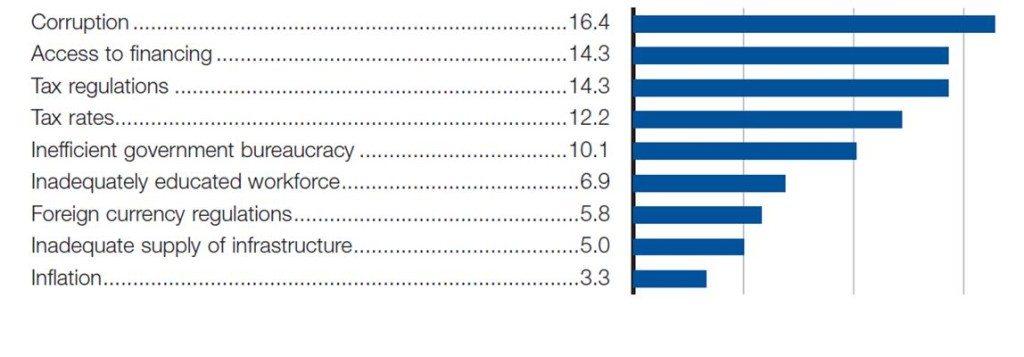




 |
 |
 |
 |
 |
VIP Forums Muzblog Chat Games Gallery. Ôîðóì, ìóçäíåâíèêè, ÷àò, èãðû, ãàëëåðåÿ. |
||||
|
||||||||
| Diaspora News and events in Armenian and other diasporas. |
 |
Global Competitiveness and Armenia |
LinkBack | Thread Tools | Display Modes |
|
|
#1 (permalink) |
|
Top VIP VIP Ultra Club
Join Date: Jan 1970
Posts: 12,055
Rep Power: 69
 |
A comprehensive global competitiveness study has been conducted by the World Economic Forum utilizing various indicators to rank 144 countries in different areas, including “Health and Primary Education,” “Technological Readiness,” and “Innovation.” This report is a short summary of the findings of that comprehensive study with an emphasis on Armenia and its neighboring countries. The study was done at a time when the global economy seems to have finally left behind the worst and longest-lasting financial and economic crisis of the past 80 years.
Much of the growth in recent years has occurred because of the extraordinary and bold monetary policies in such countries as the United States, Japan, and the United Kingdom. Overall, growth prospects in advanced economies are better than they have been in recent years, albeit very unevenly distributed. The recovery in the United States seems to be well grounded with strong output and employment figures. In Europe the picture is more mixed, with many countries now recording stronger growth, although some continue to suffer from weak growth, high unemployment, and financial fragmentation. Competitiveness has been defined as the set of institutions, policies, and factors that determine the level of productivity of a country. The level of productivity, in turn, sets the level of prosperity that can be reached by an economy. The productivity level also determines the rates of return obtained by investments in an economy, which in turn are the fundamental drivers of its growth rates. In other words, a more competitive economy is one that is likely to grow faster over time. The components of determining competitiveness were grouped into the following 12 main areas by the World Economic Forum study. Institutions: The institutional environment is determined by the legal and administrative frameworks within which individuals, firms, and governments interact to generate wealth. The importance of a sound and fair institutional environment has become all the more apparent during the recent economic and financial crisis, and is especially crucial for further solidifying the fragile recovery. Infrastructure: Extensive and efficient infrastructure is important for ensuring the effective functioning of an economy. Well-developed infrastructure reduces the effect of distance between regions by integrating the national market and connecting it at low cost to markets in other countries and regions. Macroeconomic Environment: The stability of economic conditions are important for business, and are therefore crucial for the overall competitiveness of a country. An economy cannot grow in a sustainable manner unless the macroeconomic environment is stable. Health and Primary Education: A healthy workforce is vital to a country’s competitiveness and productivity. Basic education increases the efficiency of each individual worker. Higher Education and Training: Quality higher education and training is crucial for economies that want to move up the value chain, beyond simple production processes and products. Goods Market Efficiency: Countries with efficient goods markets are well positioned to produce the right mix of products and services given their particular supply and demand conditions, as well as to ensure that these goods can be most effectively traded in the economy. Labor Market Efficiency: The efficiency and flexibility of the labor market are critical for ensuring that workers are allocated to their most effective use in the economy and provided with incentives to give their best effort in their jobs. Financial Market Development: An efficient financial sector allocates the resources saved by a nation’s citizens, as well as those entering the economy from abroad, to their most productive uses. Technological Readiness: In today’s globalized world, technology is increasingly essential for firms to compete and prosper. Market Size: The size of the market affects productivity since large markets allow firms to exploit economies of scale. Business Sophistication: There is no doubt that sophisticated business practices are conducive to higher efficiency in the production of goods and services. Innovation: Innovation can emerge from new technological and non-technological knowledge. Although less-advanced countries can still improve their productivity by adopting existing technologies or making incremental improvements in other areas, for those that have reached the innovation stage of development this is no longer sufficient for increasing productivity. Firms in these countries must design and develop cutting-edge products and processes to maintain a competitive edge and move toward even higher value-added activities. While all of the indicators described above are required for all economies, they will affect different economies in different ways. The best way for Armenia to improve its competitiveness is not the same as for France. This is because»Armenia is considered a Stage 2 development country. In a Stage 2 economy, as a country becomes more competitive, productivity will increase and wages will rise with advancing development. Countries will then move into the efficiency-driven stage of development, when they must begin to develop more efficient production processes and increase product quality. At this point, competitiveness is increasingly driven by higher education and training, efficient goods markets, well-functioning labor markets, developed financial markets, the ability to harness the benefits of existing technologies, and a large domestic or foreign market. »table 1: 2015 Global Competitiveness Overall Rankings CountryRankSwitzerland1Singapore2United States3Finland4Germany5Japan6Azerbaijan38Turkey45R ussian Federation53Georgia69Iran83Armenia85 The Global Competitiveness Index has been used as an important tool by policymakers in many countries over the years, and is widely recognized as one of the key assessments of global competitiveness. table 1 provides the rankings of Armenia, the Russian Federation, and Armenia’s neighbors, along with names of the top six ranked countries. Normally, the economic size of any country has a direct relationship with different social and justice issues. Therefore, one needs to compare the Armenian economy to other countries. The United States, with a gross domestic product (GDP) of $16,800 billion (2013), is the largest economy in the world; it is followed by China with $9,181 billion, and Japan with $4,900 billion. Armenia’s GDP in 2013 was only $10.5 billion, which makes it 120th country among 144 countries. GDP per capita is also an important indicator. In 2013, the GDP of Luxembourg, Norway, and Qatar was $100,000. The U.S. was 9th with $53,100. In comparison, Armenia’s GDP per capita was just $3,200, ranking 100th among 144 countries. table 2 shows the GDP of Armenia and its neighbors. In today’s global market economy, different countries compete for providing services and goods to other countries and multinational corporations. The competitiveness of each country is measured by indicators in 12 different areas, as explained above. Institutions are the first indicator that needs to be considered. table 3 shows where Armenia stands in comparison to its neighbors as well as with the U.S. and Russia for different institutional indicators. table 2: Gross Domestic Products CountryGross domestic product in billionsRankGDPRankRussian Federation$2,118.08$14,82049Turkey$827.217$10,8156 0Iran$366.332$4,75086Azerbaijan$73.565$7,90069Geor gia$16.2103$3,60595Armenia$10.5120$3,200100 table 3: Rankings of Institutional Indicators CountryDifferent Institutional Indicators123456789101112131415Armenia678480787610 7717643953957819022Azerbaijan918077468599555232604 840716423Georgia851063279236548678712427285416Iran861278465978968821259412712180121117Turkey47727462541015937715642901036834Russia120107102741021098787111110681011147298USA25203048363047738223447322336 List of Institutional Indicators
Numerous indicators are used to determine the overall rankings of each country. table 4 provides Armenia’s ranking in selected areas. The results indicate that brain drain is a major issue; as Armenia’s economy is not capable of retaining and utilizing talents, the main effect is mass emigration. table 4: Armenia’s Rankings in Different Areas IndicatorsRakingSoundness of banks66Availability of financial services75Country credit rating85Ease of access to loans97Effectiveness of anti-monopoly policy105Quality of math and science education69Quality of primary education83Quality of scientific research institutions105Country capacity to retain talent123 The following chart shows the most problematic factors for doing business in Armenia. Clearly corruption, financing, and tax regulations are hindering business in Armenia.  The post Global Competitiveness and Armenia appeared first on Armenian Weekly. A comprehensive global competitiveness study has been conducted by the World Economic Forum utilizing various indicators to rank 144 countries in different areas, including “Health and Primary Education,” “Technological Readiness,” and “Innovation.” This report is a short summary of the findings of that comprehensive study with an emphasis on Armenia and its neighboring countries. The study was done at a time when the global economy seems to have finally left behind the worst and longest-lasting financial and economic crisis of the past 80 years. Much of the growth in recent years has occurred because of the extraordinary and bold monetary policies in such countries as the United States, Japan, and the United Kingdom. Overall, growth prospects in advanced economies are better than they have been in recent years, albeit very unevenly distributed. The recovery in the United States seems to be well grounded with strong output and employment figures. In Europe the picture is more mixed, with many countries now recording stronger growth, although some continue to suffer from weak growth, high unemployment, and financial fragmentation. Competitiveness has been defined as the set of institutions, policies, and factors that determine the level of productivity of a country. The level of [...] The post Global Competitiveness and Armenia appeared first on Armenian Weekly. A comprehensive global competitiveness study has been conducted by the World Economic Forum utilizing various indicators to rank 144 countries in different areas, including “Health and Primary Education,” “Technological Readiness,” and “Innovation.” This report is a short summary of the findings of that comprehensive study with an emphasis on Armenia and its neighboring countries. The study was done at a time when the global economy seems to have finally left behind the worst and longest-lasting financial and economic crisis of the past 80 years. Much of the growth in recent years has occurred because of the extraordinary and bold monetary policies in such countries as the United States, Japan, and the United Kingdom. Overall, growth prospects in advanced economies are better than they have been in recent years, albeit very unevenly distributed. The recovery in the United States seems to be well grounded with strong output and employment figures. In Europe the picture is more mixed, with many countries now recording stronger growth, although some continue to suffer from weak growth, high unemployment, and financial fragmentation. Competitiveness has been defined as the set of institutions, policies, and factors that determine the level of productivity of a country. The level of [...] The post Global Competitiveness and Armenia appeared first on Armenian Weekly. [img][/img] More... |
|
|

|
 |
|
|
|